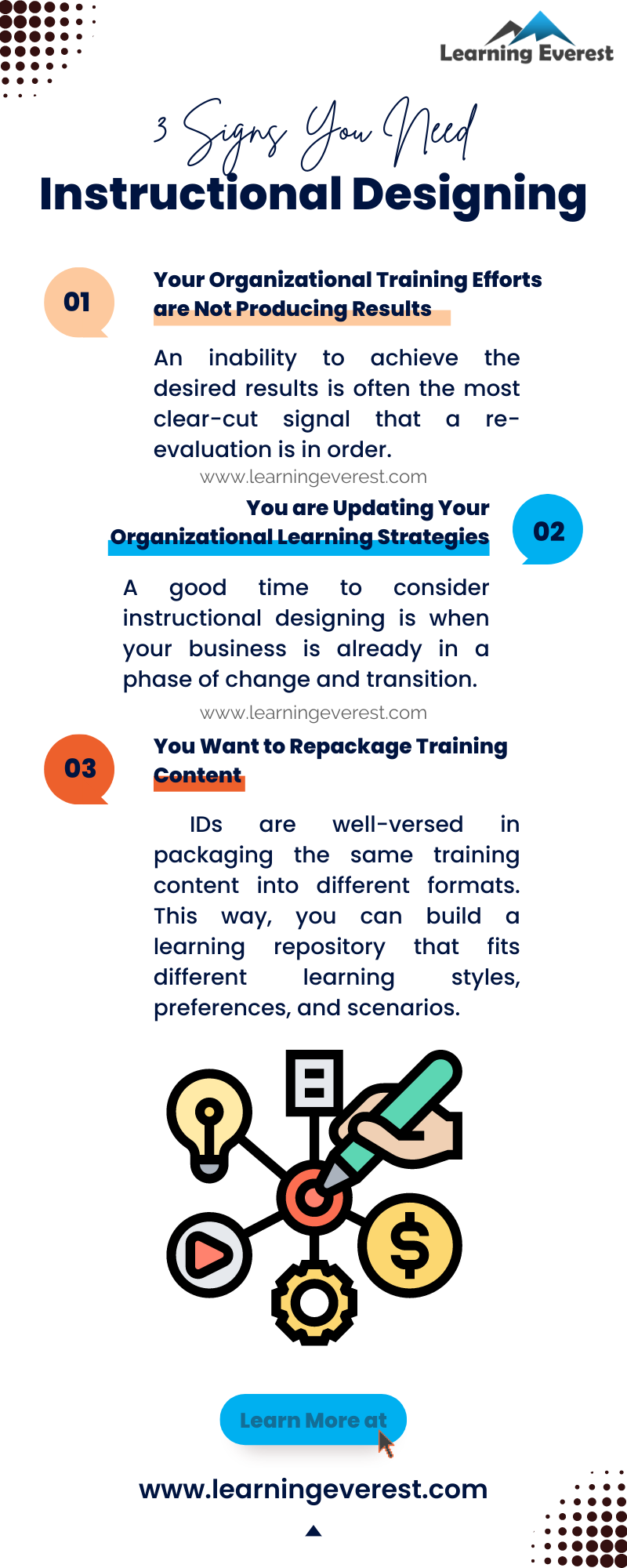Instructional designing is the process of creating learning experiences that are effective as well as engaging. Instructional designers (IDs) are often likened to architects of the learning process as they are responsible for structuring the content and sequence of learning. While instructional design in its various forms is commonly seen in schooling and academics, it is also a vital part of corporate training. All leading businesses today have in-house instructional designers or outsource the service from vendors. If you are on the fence about instructional designing, this article "3 Signs You Need Instructional Designing" will give you 3 signs that might indicate or be a good starting point for considering professional instructional designing.
Table of Contents
3 Signs You Need Instructional Designing
Reason 1: Your Organizational Training Efforts are Not Producing Results
The most obvious sign your business might need instructional designing is if your training efforts fail to:
- Meet business objectives
- Produce meaningful change in employee behaviors
- Improve employee performance
- Change the way things are done in the organization
An inability to achieve the desired results is often the most clear-cut signal that a re-evaluation is in order. Thus, if you notice a drop or plateau in employee performance and your business’ growth trajectory, it might be time to dial in the professionals.
Reason 2: You are Updating Your Organizational Learning Strategies
A good time to consider instructional designing is when your business is already in a phase of change and transition. An ID can offer guidance about multiple training areas and needs and help create worthwhile systemic changes in your organizational learning strategies.
They can also help you identify what did and did not work in your past efforts and build a strategy around your budget and learners’ requirements.
Instructional designing will also improve the functional and operational efficiency of your organization as IDs often play multifaceted roles. They bridge the gap between learners and management and can communicate and/or incorporate both parties’ expectations from training and development activities.
Reason 3: You Want to Repackage Training Content
Instructional designing can benefit you even if you already have training content. IDs are well-versed in packaging the same training content into different formats.
This way, you can build a learning repository that fits different learning styles, preferences, and scenarios.
For instance, long courses can have a full e-learning module as well as several microlearning modules for just-in-time revision after the main course has already been completed.
Another example is breaking down a compliance handbook into a self-paced narrative-based course where each compliance area is taught using context-specific story examples.
There can, of course, be other signs to consider instructional designing but these are the ones that reflect an immediate need. Once you have decided you need instructional designing, you will have to consider whether to go in-house or outsource the service.
What Kind of Instructional Designing Should You Opt For – In-house or Outsourced?
Your company’s size, budget, and time constraints will be important factors in determining which option will be better.
In-House Instructional Designing
In-house instructional designing is a great option for businesses committed to a self-sufficient and sustainable L&D solution.
Pros:
- Lower development time and cost due to easy internal communication and eliminating the cost of paying a vendor for the service
- Highly targeted and relevant learning because in-house experts interact with the target learners on a daily basis and have a better understanding of company goals
- Greater data confidentiality as the information stays within the organization
Cons
- Requires greater initial investment as hiring, training new talent, and purchasing the right tools is expensive
- Not a feasible option for small or new businesses
Outsourced Instructional Designing
In-house instructional designing is not always optimal. In fact, outsourcing these services is a very common practice in corporate training.
Pros:
- Lower initial investment as there are no hiring, training, and equipment costs involved
- IDs are up-to-date with market trends and the latest developments in e-learning meaning that your learners get the best training possible
- You get to work with a diverse and experienced pool of IDs who can offer unique insights and strategies
- Short development time as providers have pre-made templates to work from
- E-learning vendors also specialize in other related services such as learning consulting, LMS management, translation and localization, etc. which can often be bundled into cost-efficient packages for clients
Cons
- Coordination might take more effort than in-house instructional designing
- Requires more rigorous training needs analysis unless you have been working with the same vendor for a long time. This is because you will have to provide the IDs with as accurate a picture of your learners as possible.






